Chapter: Nutrition and Diet Therapy: Planning a Healthy Diet
MyPyramid
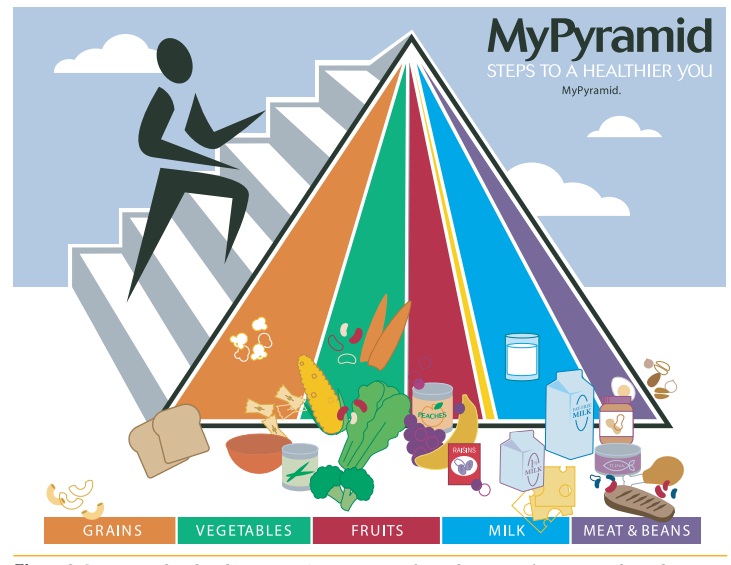
MYPYRAMID
Dietary Guidelines for Americans, 2005, serve as the U.S.
federal nutrition policy(USDHHS & USDA, 2005). These guidelines form the
basis for the MyPyramid Food guidance system unveiled in April 2005. MyPyramid
is applicable to Americans over age 2. By introducing all Americans to
MyPyramid and its slo-gan, “Steps to a Healthier You,” the USDA hopes to help
people make informed and healthier food choices. These choices can lead to a
decrease in major nutrition-related chronic diseases, such as anemia, diabetes
mellitus, coronary heart disease, hypertension, and alcoholic cirrhosis.
MyPyramid is the
former Food Guide Pyramid tipped on its side. The color bands in MyPyramid
represent the types of foods that should be con-sumed, and the width of the
band denotes the approximate relative quantity of each food that should be
consumed. In addition, MyPyramid incorporates the concept of physical activity
into its design. A person climbing the stairs denotes the importance of
physical activity in one’s daily life, just as the food groups denote daily
food intake. Personalization of one’s diet is easier to accomplish by accessing
the MyPyramid.gov Web site, where age, gender, and physical activity can be
keyed in and more specific nutrition guidelines are provided. Twelve different
pyramids are available on the Web site using these parameters. The 12 pyramids
range from daily intake levels of 1,000 to 3,200 calories. By following the
appropriate pyramid, the individual should be able to maintain a healthy body
weight and decrease the risk of nutrition-related chronic diseases. Quantities
are stated in household measures such as cups and ounces instead of the
servings that were used in the Food Guide Pyramid.
MyPyramid has the
following features:
• MyPyramid Plan.Provides a quick
estimate of what and how muchfood you should eat from the different food groups
by entering your age, gender, and activity level.
• MyPyramid Tracker(www. My pyramid tracker
.gov). Provides moredetailed
information on your diet quality and physical activity status by comparing a
day’s work of foods eaten with current nutrition guidance.
• Inside MyPyramid.Provides in-depth
information for every foodgroup, including recommended daily amounts in
commonly used measures, like cups and ounces, with examples and everyday tips.
Included in this section are recommendations for choosing healthy oils,
discretionary calories, and physical activity.
• Start Today.Offers tips and
resources that include download able suggestions on all the food groups and
physical activity and provides a downloadable worksheet to track what you are
eating.

MyPyramid (Figure 2-1)
has six color bands representing five food groups and oils. The bands are wider
at the bottom, representing foods with little or no solid fats, added sugars,
or caloric sweeteners, and become narrower at the top, in-dicating that the
foods that contain fats and sugars should be limited. The five food groups
represented along with oils have not changed. They are the following:
• Grains—bread, cereal, rice, and pasta group • Vegetable group
• Fruit group
• Milk, yogurt, and cheese group
• Meat, poultry, fish, dry beans, eggs, and nuts group • Fats, oils, and sweets group
The emphasis of
MyPyramid, which takes its guidance from the DietaryGuidelines for Americans, 2005, is not on a percentage of
intake but on dailyservings. Depending on the information one enters into
MyPyramid, a calorie level will be individually determined. See Table 2-6 for
intake patterns for various caloric levels.
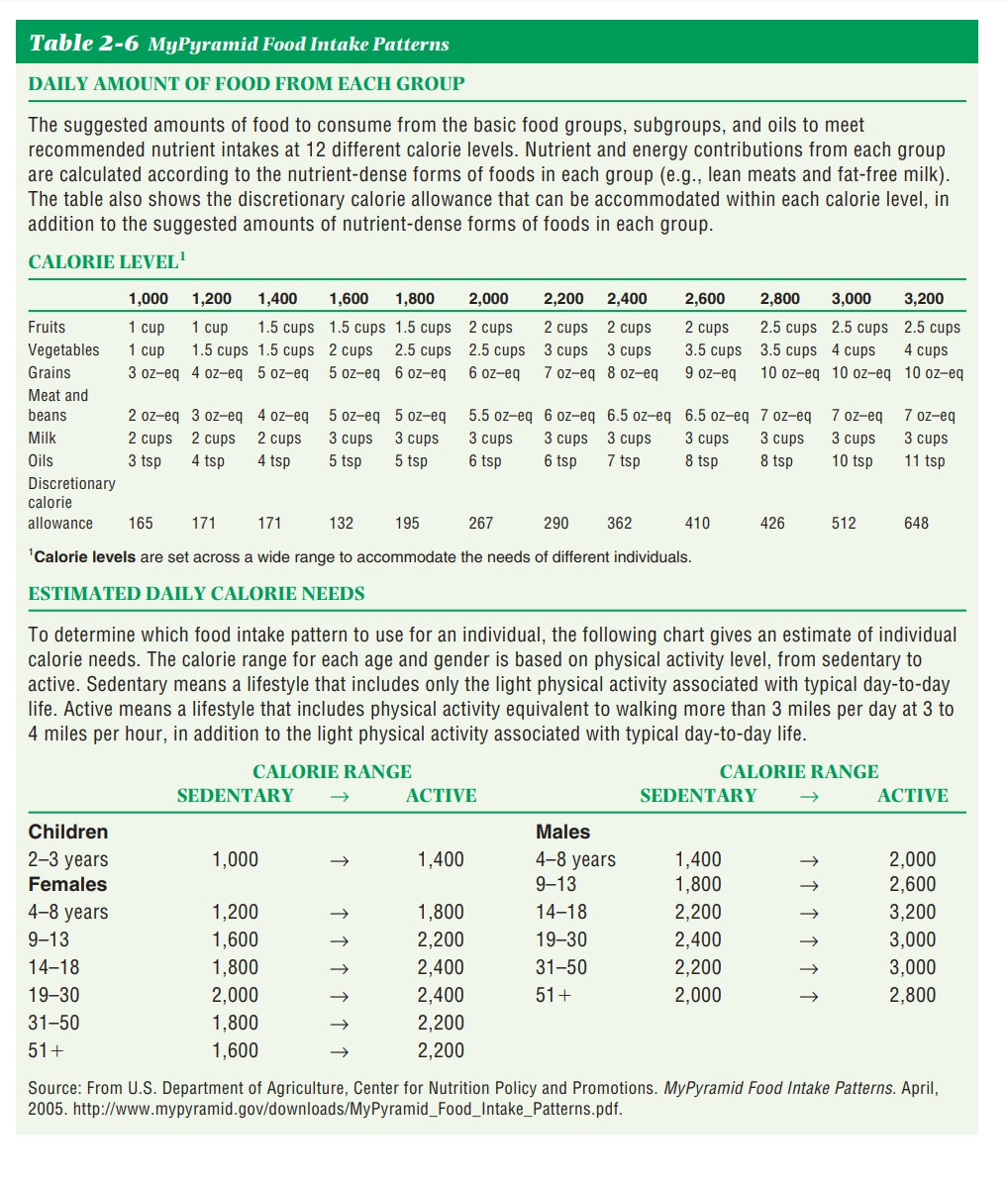
Bread, Cereal, Rice, and Pasta Group
The largest section of MyPyramid is made up of the grains—the bread, cereal, rice, and pasta group (Table 2-7). As the table shows, the number of servings from grains is established with the recommendation that at least half of the servings should be whole grains. Whole grains provide dietary fiber, B vitamins, iron, and magnesium. Enriched products also contain B vitamins and iron, but if they are not made from whole grains, they contain little dietary fiber.
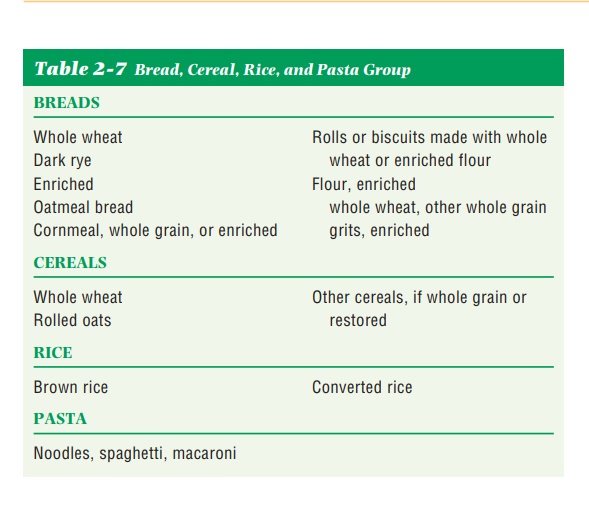
Vegetable Group
The food intake
patterns have established the number of daily servings per calorie level of
vegetable. All vegetables are included in the vegetable group: green and leafy,
yellow, starchy, and legumes (Table 2-8). Vegetables provide carbohydrates;
dietary fiber; vitamins A, B-complex, C, E, and K; and iron, calcium,
phosphorus, potassium, magnesium, copper, manganese, and some-times,
molybdenum.
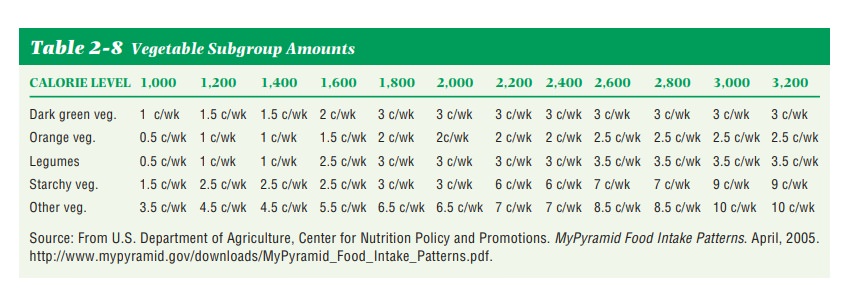
This guideline, if followed, also guarantees that one will receive a vari-ety of nutrients, phytochemicals, and flavonoids. One-half cup of cooked or chopped raw vegetables or two cups of uncooked, leafy vegetables is considered one serving.
Fruit Group
All fruits are
included in the fruit group. They provide vitamins A and C, potas-sium,
magnesium, iron, and carbohydrates, including dietary fiber (Table 2-9).
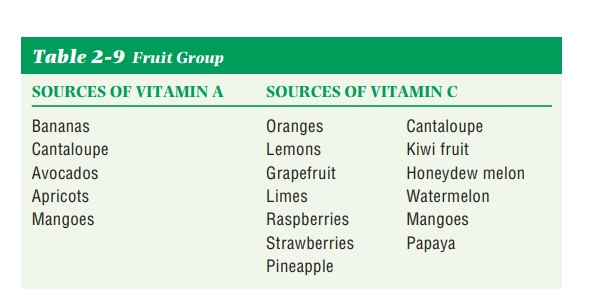
It is recommended that
one eat a variety of fruit daily, following the food intake patterns for
quantity, and go easy on the fruit juice. The calories in fruit juice add up
quickly, especially if one is thirsty and drinks large amounts of juice. One
serving is three-quarters cup of fruit juice; a half of a grapefruit; one whole
raw medium apple, orange, peach, pear, or banana; a half cup of canned or
cooked fruit; and a quarter cup of dried fruit.
Milk, Yogurt, and Cheese Group
Milk, yogurt, and
cheese are excellent sources of carbohydrate (lactose); cal-cium, phosphorus,
and magnesium; proteins; riboflavin, vitamins A, B12, and, if the
milk is fortified, vitamin D. Unfortunately, all contain sodium, and whole milk
and whole-milk products also contain saturated fats and cholesterol. Fat-free
milk has had the fats removed.
It is recommended that
two to three servings of these foods be included in one’s daily diet. The
serving size is one 8-ounce glass of milk or the equivalent in terms of calcium
content.
Children 2 servings
Adolescents 3 servings
Adults 3 servings
Pregnant or lactating
women 3 servings
Pregnant or lactating
teens 4 servings
The following dairy
foods contain calcium equal to that found in one 8-ounce cup of milk. The best
choices would be low fat.
• 11⁄2ounces cheddar cheese
• 2 cups cottage cheese
• 13⁄4cups of ice cream
• 1 cup yogurt
Milk used in making
cream sauces, gravies, or baked products fulfills part of the calcium
requirement. A cheese sandwich would fulfill one of the serv-ing requirements,
and a serving of ice cream could fulfill half of one of the serving
requirements. Obviously, drinking milk is not the only way to fulfill the
calcium requirement.
Some clients suffer
from lactose intolerance and cannot digest milk or milk products. If they eat
or drink foods containing untreated lactose, they experience abdominal cramps
and diarrhea. This condition is caused by a defi-ciency of lactase. In such
cases, milk that has been treated with lactase can be used, or commercial
lactase can be added to the milk or taken in tablet form before drinking milk
or eating dairy products.
Meat and Beans Group
All meats, poultry,
fish, eggs, soybeans, dry beans and peas, lentils, nuts, and seeds are included
in this group (Table 2-10). These foods provide proteins, iron, copper,
phosphorus, zinc, sodium, iodine, B vitamins, fats, and cholesterol.
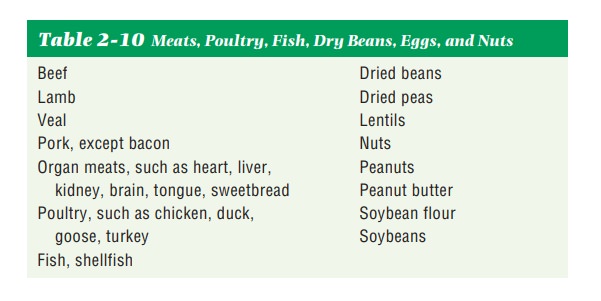
Caution must be used
so that the foods selected from this group are low in fat and cholesterol. Many
meats contain large amounts of fats, and egg yolks and organ meats have very
high cholesterol content.
Let the food intake
patterns be the guide for the number of ounces one should eat daily. In
general, 1 ounce of lean meat, poultry, or fish, 1 egg, 1 table-spoon of peanut
butter, 1 ⁄4 cup of cooked dry beans, or 1 ⁄2 ounce of
nuts or seeds can be considered as a 1 ounce-equivalent from the meat and beans
group.
Fats
This group contains butter, margarine, cooking oils, mayonnaise and other salad dressings, sugar, syrup, honey, jam, jelly, and sodas. All of these foods have a low nutrient density, meaning they have few nutrients other than fats and carbo-hydrates and have a high calorie content. One’s limit for fat will be figured and listed as oils in accordance with the food intake patterns shown in Table 2-6. It is recommended that the fat sources be from fish, nuts, and vegetable oils.
The Mediterranean diet
has received attention because of the American Heart Association’s
recommendation to increase monounsaturated fats in the diet. The following
guidelines are recommended:
·
Eat the majority of food from plant sources,
such as potatoes, grains and breads, beans, fruits, vegetables, nuts, and
seeds.
·
Eat minimally processed foods, with an
emphasis on fresh, locally grown foods.
·
Replace other fats and oils with olive oil.
·
Keep total fat in a range of less than 20–35%
of energy. Saturated fat should be no more than 7–8% of energy.
·
Eat low to moderate amounts of cheese and
yogurt (low fat and fat-free preferable).
·
Eat low to moderate amounts of fish and
poultry and from zero to four eggs per week (those used in cooking need to be
counted).
·
Eat fruit for dessert; desserts that contain a
significant amount of sugar and saturated fat should be eaten only a few times
per week.
·
Eat red meat a few times per month, not to
exceed 12–16 ounces per month.
·
Engage in regular exercise to promote fitness,
a healthy weight, and a feeling of physical well-being.
·
Drink wine in moderation (wine is optional).
Wine with meals—one to two glasses per day for men and one glass per day for
women.
Related Topics